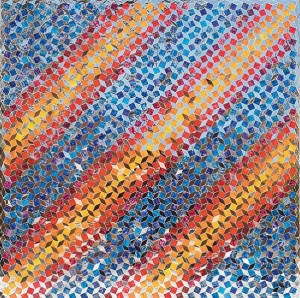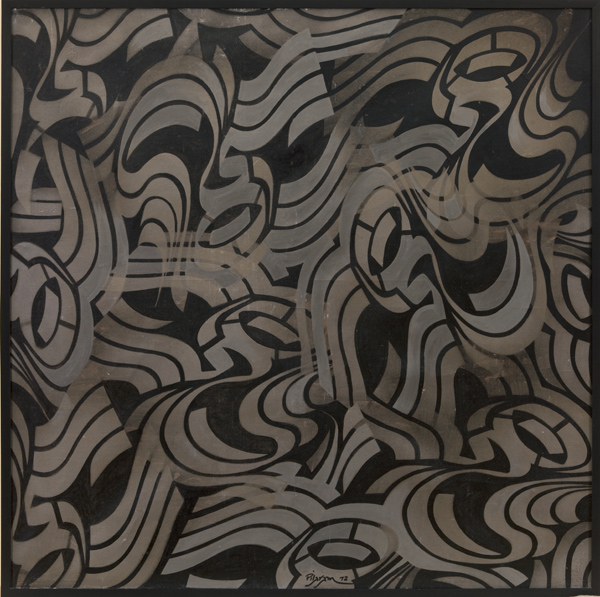
Monir Shahroudy Farmanfarmaian, Untitled, 1977. Mirror, reverse-glass painting and plaster on wood. H. 41 1/2 x W. 41 1/2 (105.4×150.4) Zahra Farmanfarmaian / Photo: Joshua Sage / Courtesy of Asia Society Museum
During a recent trip to New York, I was lucky enough to visit the intriguing exhibition Iran Modern hosted at the Asia Society Museum located on 70th Street and Park Avenue. The exhibition is a body of works created almost thirty years before the 1979 revolution that affected the lives of many Iranians. Prior to the revolution, Iran was at the midst of a cultural and economic prosperity, abundant with the promise of great artistic talent, hope and innovation.
Although criticized by the non-elitist population and even some of the artists featured in the show, there’s no doubt that art flourished during the oppressive reign of Mohammad Reza Pahlavi, Shah of Iran (who reigned from 1941-1979) and his wife Farah Diba. For example, numerous galleries opened in Iran, art festivals were organized, the Tehran Museum of Contemporary Art was inaugurated, artists traveled abroad, western artists such as Andy Warhol visited Teheran…In a nutshell, art was booming! And the transparency of Iran to the rest of the world was at its peak.
Iran Modern is one of the many shows about the art and artists of that country taking place in the art scene this year. The exhibit explores the works of 26 artists and the respective cultural results of their lives in pre-1979 Iran. The show is thematically organized; The first floor includes the following themes: the Saqqakhaneh movement –influenced by Shi’ite folk and pre-Islamic art, Abstraction and Modernism, Calligraphy and Modernism. While the second floor of the exhibition is dedicated to political art.
Throughout the show the co-curators of the exhibition Fereshteh Daftari and Layla S. Diba are trying to point out the artistic and modernist ideologies of Iranian artists. Art helps us understand and appreciate one another; art that one expected to be so different is actually the same. The actual setup of the show was not as utopic however! While the United States, Europe and the Middle East collaboratively funded the exhibition, the tense relationship between the governments of the US and Iran is still prevalent. The main challenge of the show was that the curators were not allowed to borrow any art from Iran, due to the prevailing restrictions on the country. Thus, art from the Tehran Museum of Contemporary Art and Iranian private collections were not allowed to be included.
In his review of the exhibit, Robin Cembalest of ARTnews includes the frustration of Fereshteh Daftari, one of the curators of the show about the sanctions imposed on art: “I find it highly disconcerting that sanctions should affect the representation of Iranian modern art.”
Moreover, with new opportunities come new risks and new problems to take into consideration. Museum consultant Elaine Heumann Gurian discussed the cultural context of objects in her report What is the Object of this Exercise?– a survey about the meaning of objects in a museum setting. She writes: “Objects lose their meaning without the viewer’s knowledge and acceptance of underlying aesthetic or cultural values.” It is the curator’s job to link the object with its historical context and above all establish a link between the object and the viewer. Still, Gurian raises the following question:
When exhibiting art from another culture, should the curator choose works based on the “other” culture’s values and taste or choose to exhibit pieces pertaining to the values and taste of his or her own culture?
In the case of Iran Modern, curators chose to focus on a common ground to both Iranian and Western cultures by focusing on the concept of modernism. A sweetened approach to eliminate boundaries and also attract a larger audience.
As a whole, the artistic community is looking to expand globally and bring to light the art of other cultures. Cembalest explains that there is a growing phenomenon common to the biggest museums today: “globalize art history.” With Japan’s postwar avant-garde at the MoMA and the Guggenheim, Indian Modernism at the Rubin, Latin American abstraction at the Reina Sofia, and the show of Sudanese painter Ibrahim El-Salahi at the Tate, curators are broadening the cultural scope of their respective museums as well as their audience.
For more info about the show check out: TheAsiaSociety and NYTimes’s review

